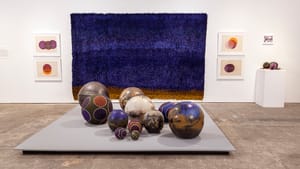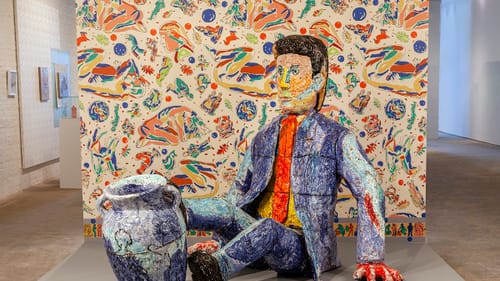Stay in the Loop
BSR publishes on a weekly schedule, with an email newsletter every Wednesday and Thursday morning. There’s no paywall, and subscribing is always free.
Creative disruption
The Fabric Workshop and Museum presents Hard/Cover

Hard/Cover is about artists getting out of their comfort zones. It considers what happens when something familiar is done in a new way—in this case, when ceramicists and sculptors incorporate fiber and screen-printing into their practice. The Fabric Workshop and Museum (FWM) exhibit, presented in partnership with The Clay Studio and curated by FWM’s Karen Patterson, features 10 artists whose FWM residencies changed their art.
Creating context
Viola Frey (1933-2004) had already shifted from paint to clay by 1991, when she began a FWM residency in which she designed wallpaper and fabric decorated with iconographic markings. In FWM’s eighth floor gallery, Frey’s Artist’s Mind/Studio/World (1992) serves as a backdrop for her monumental ceramic Man Balancing Urn (2004), in which a man in suit and tie sits with legs outstretched, feet delicately tipping a garden urn on its edge.
Woody De Othello faced a challenge beyond collaboration during his 2020-2021 residency: Covid dislocation. The pandemic forced the California-based sculptor, known for anthropomorphized figures in ceramic, bronze, wood, and glass, to work remotely with FWM artists. In the gallery, De Othello’s fabric and wallpaper backs his sculpture, all shaped by long-distance collaboration and quarantine.
Miscommunication (2021) is a silvery gray conglomeration of telephone receivers spanning the last several decades, accompanied by a generous pair of ears—the only element that hasn’t been redesigned, and the one on which everything else depends. Behind it, white wallpaper with scratchy cobalt stripes suggests staticky sound. “I’m trying to communicate that although times have been very challenging,” De Othello said, “there are better days ahead.”
Interpreting the past
While De Othello looks with hope to the future, Jane Irish looks back in Goya’s Dream (2021), a multipart installation summarizing the history of the world. Principally known as a painter, Irish created a lesson in ceramic and fabric referencing the spice trade and exploration, colonialism and enslavement, and the ongoing struggle among violence, freedom, and peace. As in all of Irish’s work, worlds, eras, and ideas collide.
Overhead in the installation, Cosmos (2020), a churning blue-and-white print Irish made in collaboration with FWM, represents a troubled sky. Underfoot, brown and white scrolled tile signifies earth and old world elegance. Between the two, a flotilla of whiteware ships line up on a tabletop with sails furled, as if caught in the doldrums. In a nearby vitrine, a dish of potpourri stands by, maybe a symbol of what started the trouble: a desire for luxury and wealth that caused ships to sail, explorers to conquer, and conquerors to enslave Indigenous people and plunder their resources.

Beyond utility
Betty Woodman’s (1930-2018) practice spanned a period in which lines blurred between fine and decorative art, and between pieces that were expressive and functional. Like Frey and Toshiko Takaezu (1922-2011) she shifted from making artistic utilitarian works to solely aesthetic pieces. Many FWM residencies coincide with this sort of turning point.
Presenting Food Napkin Holder (1985), billed as Woodman’s last functional work, clearly announces her evolution. It fills the center of a table laid with Presenting Food Tablecloth (1984), created in collaboration with FWM. Calling Woodman’s ceramic centerpiece a napkin holder is like calling the Statue of Liberty a candle stand, and it would take a host of some confidence to insert napkins in the barely noticeable slot atop this epergne.
Throughout her career, Takaezu crafted stoneware orbs, called moons, to invoke a sense of completeness and infinity. A serene galaxy Takaezu created from 1970 through the 2000s is on view, not far from a grouping of wool, silk, linen, and rayon Moon Balls (1992) made during her FWM residency. To decorate the soft lunar surfaces, the artist resurrected designs she’d drawn decades before, rendering them in autumnal rust, purple, and moss.
Resident synergy
Mark Barrow and Sarah Parke, spouses who as Barrow Parke share a practice fusing textile fabrication, computer coding, and modernist design, contributed a meditation on vessels. In Vessels (2020), a length of cotton sateen woven by Parke and painted by both artists bears ancient fertility symbols and statues. It’s the backdrop for about 50 tiny ceramic vessels perched on 50 tiny shelves, no two exactly alike.
Barrow Parke’s work inspired another FWM resident, ceramicist Shino Takeda, to create Through Space (2021) employing monoprinting, in which an artist applies ink directly onto fabric through the print screen. Results vary with each sweep of the hand, recording gestures rather than mechanically reproducing an image. Takeda was initially dubious about trying the technique: “If I think too much about it, I start to doubt it. In the end, I have to learn how to trust my instinct.”
It seems axiomatic to say that artists are instinctive, easily accepting the “inherent uncertainty of the creative process,” as gallery text terms it. Hard/Cover demonstrates that artists are as susceptible as the rest of us to the security of habit, of sticking with what works, of ignoring or suppressing ideas that seem too far afield, too out of character. Yet when humans are disrupted from their routine, whether by collaboration or an unforeseen circumstance, such as a global pandemic, exciting new ideas have the chance to rise.
What, When, Where
Hard/Cover. Through September 26, 2021, at The Fabric Workshop and Museum, 1214 Arch St., Philadelphia. (215) 561-8888 or fabricworkshopandmuseum.org.
As of July 29, 2021, all FWM visitors must wear a face mask. Because of limited capacity, advance registration is encouraged.
Accessibility
FWM’s main entrance is accessible to standard-size wheelchairs, and manual wheelchairs are available to borrow on a first-come, first-serve basis. The entrance does not have an automatic opener. All floors are accessible by elevator, and accessible, single-user restrooms are available. Service animals are welcome.
For information, call (215) 561-8888 (voice), or email [email protected].
Sign up for our newsletter
All of the week's new articles, all in one place. Sign up for the free weekly BSR newsletters, and don't miss a conversation.
